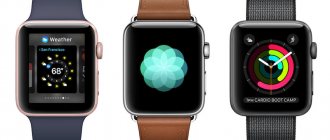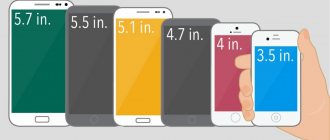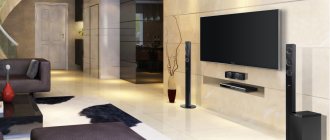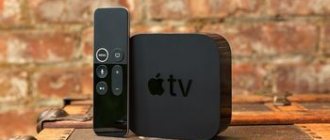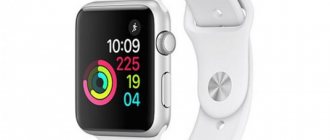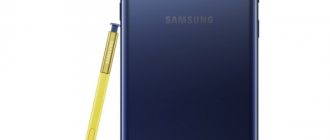Before purchasing a TV with Smart TV function, many people wonder: what brand of TV is best to buy? Most often they choose between LG and Samsung brand models, which is not surprising. These companies have proven their superiority and are distinguished by the best qualities. But still, which TV is better than LG and Samsung? You can find a large number of forums and articles on this topic, however, the answers to them are different. This is due to the fact that many factors have to be considered, relating to both technical characteristics and pricing policy. In addition, everything depends on the specific model. Today we will try to look at TVs with the Smart TV function from these two companies and find out which of them is better and in what way.
LG or Samsung TV: which is better?
The analysis of models should begin with the appearance and diagonal. The equipment must be in harmony with the furniture and interior of the room.
The price tag of the TV, the picture quality, and viewing comfort depend on the diagonal parameter. The table below shows suitable options according to the area of the room.
| Diagonal (inches) | Area (sq.m.) |
| Less than 20 | 6-9 |
| 26-32 | 10-16 |
| More than 50 | More than 16 |
When solving the dilemma of which TV is better than LG or Samsung, you should also rely on the following aspects:
- Device design;
- Quality of the working matrix;
- Picture and sound parameters;
- Viewing angle;
- Game mode;
- Number of connectors;
- Supports Smart or 3D options.
How do LG and Samsung TVs differ in appearance?
The species is the determining criterion. It is at first that it attracts the attention of buyers. Externally, the devices of these brands have minor differences. The common features are:
- Monitor with 4K resolution;
- Slight display bezel.
These TVs are usually wall mounted. But:
- The LG stand has the shape of a curved semicircle and rotates easily.
- The Samsung TV leg is static. Its shape is classic rectangular. The leg extends beyond the back panel. For this reason, difficulties often arise with wall mounting.
The width of the edging is identical for both brands. Many Samsung representatives have greater depth, for example, the LED-4k UHD model.
Variations are available with different screen parameters. But the price tags of TVs can be the same, no matter what diagonal the screen is. Example: the screen of the LG 42LB673V is 42 inches, and the Samsung UE40F613OAK is 40 inches. And the price tag for both is 25,000 rubles.
What to consider when purchasing
LG and Samsung are large South Korean electronics and home appliance firms that compete fiercely with each other. Despite having the same parameters, their TVs differ in some individual features. Therefore, the choice of brand will depend on the personal needs of the buyer.
You need to start with the appearance, since the new item should be organically combined with the furniture and design of the room. The diagonal size determines not only the cost of the device, but also affects the viewing quality. Displays up to 20 inches are recommended for rooms of 6-9 m2, if the area is larger, choose a screen of 26-32 inches. For sizes larger than 16 meters, displays larger than 50 inches are allowed.
In addition, the following parameters are compared:
- design;
- matrix quality;
- picture and sound parameters;
- viewing angle.
Important! Additional features are considered when purchasing: game mode, number of connectors, support for Smart or 3D functions.
Appearance
This is a decisive parameter; attention is paid to it first. Externally, LG and Samsung TVs differ slightly; they have a large 4k resolution monitor and a small display frame.
They are often installed on the wall. However:
- the LG stand has a semicircular curved shape and is easy to rotate;
- The Samsung leg is motionless, with a classic rectangular shape, protruding beyond the back panel, so there may be problems with installation on the wall.
The width of the edging is the same for both brands. The depth of Samsung's LED-4k UHD is greater, although this also depends on the model.
Models are available with different screen sizes. But TVs can have the same price regardless of screen size. For example, LG 42LB673V has a 42-inch screen, and Samsung UE40F613ОАК has a 40-inch screen, although the price of both models is 25 thousand rubles.
For those who like the unusual, Samsung produces devices with a 24-40-inch display that looks like a picture or photograph frame.
Attention! The distance from the viewer's eyes to the display should be 5 times the size of the screen. Therefore, with a 42-inch diagonal, you will need to watch TV from a distance of 5 meters, and if you choose 42 inches, you will need to watch TV from a distance of 5.3 m.
Image
Image quality is considered an important parameter. Inexpensive models are practically the same in this regard, but mid- and premium-class models are characterized by a wide range of image parameters.
The picture depends on the technologies used:
- Plasma TVs with Smart TV function. LG abandoned this technology. Samsung applies the latest developments and produces modern, improved devices. Therefore, plasma lovers stop at
- LED and LSD technology. Products from LG reproduce color better, while Samsung displays are rich in color and reproduce deep blacks. Both companies produce models with glossy or matte monitors in 4K resolution, but if you compare Samsung and LG TVs, Samsung has much better backlighting; it does not glow around the edges.
- QLED and OLED. This is a separate line that is gaining popularity and is highly expensive. These technologies combine the properties of LCD and plasma, have an anti-glare filter, and increased brightness parameters, so they are suitable for bright rooms.
You can turn off any pixel on the screen, and this gives a beautiful image in the dark. They are silent, do not heat up, the pixel response is 0, and the picture is adjusted to your liking.
Both companies produce models with HD (1280 x 720) and Full HD (1920 x 1080) resolutions. But the highest quality picture is provided by Ultra HD (3840x2160) or 4K (3840x2160).
Note! It is important to consider response time. If it is higher than 8 ms, during dynamic scenes the image will blur and move jerkily. This parameter is present in all Samsung devices, but LG often does not indicate it in the data sheet.
Matrices
Samsung almost always uses a VA matrix, with the exception of the model with a 43 diagonal. The VA matrix has a low price, good contrast, and is suitable for those who watch TV while sitting opposite it.
For a good view from the side, above or below, it is better to choose an IPS matrix with wide viewing angles (up to 180°). Such a matrix, capable of transmitting beautiful natural colors, is used in LGI TVs.
The contrast in this matrix is low, so the colors will be soft without sharp changes. The LG processor does not have sharp edges or ladders, and there are fewer details in the shadows.
Brightness and Contrast
Contrast varies depending on the LCD panel. Plasma is considered the leader in this parameter, but the recently introduced LED backlight of the LCD screen also provides a high degree of contrast and brightness:
- The VA panel in Samsung models has great contrast. Almost all have Edge-LED backlighting.
- On LG models, contrast is adjusted automatically. The company has equipped them with Direct-LED backlighting, which improves this parameter and makes it possible to watch TV in a bright room. The IPS matrix is characterized by bright, deep colors.
When the question arises, which TV is best to choose, remember that Samsung is characterized by contrast, but loses in other parameters. It is important to evaluate brightness only in comparison with contrast. The optimal combination is a contrast of 10,000 to 1 and a brightness of 400 cd/m2.
Important! The brightness values for both brands are the same, amounting to 350 nits. Above 400 nits, the image becomes blurry and unpleasant to watch.
Smart TV
“Advanced television” includes several software functions that, from a simple TV, create a complex device with the functions of a computer and a television receiver. You can use the Internet in the same way as using a tablet or phone.
By default, programs allow you to access social networks and receive news. Different operating systems are used, for example, LG uses Web OS 3.5, and competitors use Tizen. Both systems work quickly, especially in 4K.
When comparing TVs from LG and Samsung, it turns out that the latter copes better with this technology, although LG is also not particularly far behind.
The Samsung interface is considered the most convenient and is characterized by the following advantages over its competitor:
- consists of 5 segments, which simplifies management;
- The graphics are nice and bright;
- free widgets for IPTV included;
- good speed, does not freeze, does not glitch;
- The firmware is updated independently;
- many third party offers.
Important! Therefore, Samsung is considered a recognized leader in the Smart TV technology market. However, pirated models that enter the country illegally require unlocking after the update.
Sound
Modern models make it possible to select a sound mode, for example, to watch sports broadcasts, the broadcast mode is turned on.
However, it cannot be said that sound delivery is considered a strong point in modern TVs:
- LG offers a Clear Voice system that makes the human voice natural and muffles background noise. Smart Sound automatically adjusts sound based on on-screen activity.
- Samsung has developed the SRS Theater Sound feature, which improves the performance of the built-in speakers, resulting in clear sound with voice highlighting, and automatic volume adjustment depending on the image on the screen. It also uses Sports Mod technology, which is capable of transmitting even the most subtle sounds, such as a splash of water.
It is advisable to buy a model with at least 4 speakers, and the size of the speaker should not be more than 6 cm. You should not pay attention to the power; it does not affect the sound quality. It is recommended to choose a device whose technical data sheet indicates intensity “i”.
Attention! Be prepared for the fact that even with the most advanced technologies, low frequencies are not transmitted, so lovers of modern rhythms and special effects are recommended to connect a home theater or subwoofer.
Newest technologies
Both manufacturers, except Smart System, offer viewing of 3D movies. This usually applies to premium lines, so this option is rarely used yet.
Samsung's 3D quality is better, but the glasses weigh more, require frequent battery changes, and your eyes get tired faster. Competitors have less eye strain, glasses are lighter, but the image is worse.
There is voice control, recording programs or TV shows, the ability to view graphic or video files in 4k resolution mode, and play games.
All TVs are connected to a computer, any type of television, to Wi-Fi, and can be controlled from a smartphone.
For this purpose, the “LG TV Remote” and “Samsung Smart View” applications have been introduced to switch channels and adjust the volume. It is possible to display content from your phone on a large TV screen. Both companies produce remote controls with a laser pointer.
Price
Prices for TVs of both brands are in approximately the same range, from quite cheap to quite high. Depends on functions, parameters, technical features, country of manufacture, store markups.
When comparing price and quality, LV is more advantageous. This brand always costs less than Samsung with the same characteristics, screen resolution, and functions.
Let's take, for example, 2 LCD TVs with a 32-inch monitor, and study their differences and identical properties:
| Characteristic | LG 32LB650V | Samsung UE32H6410 |
| Permission | 1920/1080 | 1920/1080 |
| operating system | WebOS | Android, iOS |
| LED backlight | There is | There is |
| Update frequency index | 100 Hz | 200 Hz |
| Sound, power | 20 W | 20 W |
| Power consumption | 65 W | 80 W |
| Wall mount | There is | There is |
| Weight | 8.4 kg (6.3 kg without stand) | 5.6 kg (5.3 kg without stand) |
Both models have the same set of connectors, support Wi-Fi, have Smart TV, 3D, child lock, teletext, sleep timer, voice and gesture control functions. It is possible to connect a flash drive. At the same time, the LV operating system works slowly, and Samsung has a higher cost.
Before purchasing, it is worth studying the opinions of people who already use such brands. Some people like LGi, since this company usually thinks through even the little things, they even give you the opportunity to turn on or turn off the backlight on the remote control. Other people are satisfied with the speed of Samsung devices, in which all operations are performed instantly
Advice! When choosing, it is better to look not at the brand, but at the characteristics.
Comparison of LG and Samsung TVs by image
The budget versions of both brands do not have any special differences. But for products from the mid-range and luxury categories, there are serious discrepancies in this criterion.
The image is affected by the technologies used. They are reflected in the table below:
| Technology | LG | Samsung | Notes |
| Smart TV | No | Innovative developments | Those who want to purchase plasma choose Samsung |
| LED and LSD | Better color reproduction | Saturation, deep black color reproduction. | Both brands have equipment that has a 4K monitor. But Samsung has a better backlight. |
| QLED and OLED | Both brands release HD and Full HD devices. The parameters of the first: 1280 x 720. The second - 1920 x 1080. The highest quality images are achieved in models with Ultra HD support. These are the values: 3840x 2160 | ||
| Response speed | Often this indicator is not reflected in the passport. | If the parameter is higher than 8 ms, then in dynamic scenes the picture is blurred and jerky. | |
What criteria to pay attention to
You can determine which TV is better for yourself after evaluating the following characteristics:
- Screen diagonal is perhaps the most important quality for a home TV. The level of comfort and impressions from watching videos greatly depends on the diagonal of the screen. Watching shows on a large TV is much more fun than on a small one. At the same time, the diagonal should match the size of the room in which you place the TV. Otherwise, you risk suffering from gradual loss of vision, headaches and eye irritation.
- The design of modern TVs, as a rule, is distinguished by its laconic forms and versatility. Manufacturers are trying to reduce the border of the screen, make the body thinner, and make the leg as less noticeable as possible. However, you should know that designers create not only template products, but also regularly delight the world with new original ideas. Screens with curved surfaces and displays that act as mirrors when turned off are gradually gaining popularity. For a good mirror TV, you can order a casing edging that looks like picture frames.
- Screen resolution affects picture quality. The worse the quality, the smaller the screen should be. A poor quality picture on a large screen, viewed at close range, is very irritating to the eyes. Therefore, when purchasing a large-diagonal TV, be sure to pay attention to its resolution. The best TVs now have standard 4K resolution, which is being widely distributed by TV equipment manufacturers. For Russia and most of the rest of the world, such high quality is not relevant, because there is still too little content in this resolution. However, over time, the popularity of this resolution will grow. Then it will occupy the same place in life that 1080p resolution now occupies. It's up to you to decide whether you want to try out the achievements of modern technology early or are completely satisfied with other quality standards for now.
- Response time is an important parameter that determines the speed and smoothness of frame changes in dynamic scenes. This setting can have an impact on your viewing pleasure if you like action, adventure and sports. It is most important for players who use the TV as a display to display games from the console. The lower the response time, the faster the image on the screen keeps up with your actions and commands. With a high monitor response time, serious sticking is possible, which will regularly spoil the pleasure of the game, preventing you from completing levels and winning matches. If the manufacturer does not indicate this indicator in the documentation, find out how to choose an LG TV with the optimal response time from customer reviews.
- The sound quality from the built-in speakers cannot be compared to the sound of a full-fledged system with a subwoofer. Connecting good separate speakers costs more, takes up more space, and requires free and suitable connectors on the TV body. Of course, some sound reproduction devices are compact, do not require wires and do not put a strain on the budget. For example, headphones with Bluetooth connection. However, not all TVs, even good and expensive brands, are equipped with Bluetooth functionality. In addition, headphones and external speakers may temporarily fail, get lost, or be borrowed. You don’t have to run to the store every time a minor problem happens, just to avoid having to endure the disgusting creaking noise from the built-in speakers for an extra minute. Based on these considerations, what is better is when the sound from the TV has at least some acceptable sound quality.
- Brightness, contrast and color rendition have a huge impact on the viewing experience. On some screens, it is difficult to make out image details in dark scenes. Significant color distortions lead to poor understanding of directorial and camera decisions, and sometimes spoil the entire film.
- The viewing angles should be larger, the better. With high viewing angles, you can enjoy the movie from anywhere in the room. This is especially important in large families in which a large number of people watch TV at the same time. When the TV's viewing angles are not wide enough, even a slight change in position on the sofa or chair can cause scenes to become dark and all colors to be distorted. To compare the viewing angles of different TVs, walk around them in a showroom. Feel free to move in and out of the devices you are studying, and ask the consultant for a chair.
- Accessing the Internet via TV is very convenient. The owner of a Smart TV can watch video blogs from their favorite channels, access online movie libraries and watch them without tedious preliminary downloading, and also communicate with loved ones via chat or video without leaving the TV.
- The presence of additional features on the TV is optional. There's no point in overpaying for features you don't need. However, if something can significantly simplify and improve the quality of your life, there is no point in denying yourself it.
Leave a request and receive a 15% discount on your first repair!
Submit your application
Comparison by matrices
Samsung technology uses a VA matrix. The only exception is a device with a diagonal of 43. This matrix is characterized by an acceptable price tag and high-quality contrast. This is a great option for those who sit opposite him while watching TV.
For better viewing from the side, bottom or top, an IPS panel is ideal. LG developers are actively using it. Its potential:
- Viewing angles reach 180 degrees.
- Rendering elegant natural colors.
- A modest contrast. Therefore, the colors come out without serious differences.
- There are no sharp edges or stairs. Less detail revealed in shadows
Which TV is better to buy in the middle class?
Considering the price/quality ratio, NanoCell takes the lead here for the following reasons:
- peak brightness is higher than that of IPS matrices;
- the price/quality ratio is better than that of QLED matrices;
- there are several 4K lines that differ in price;
- Each model from 43 to 49 inches has good sound and a fresh processor.
We no longer analyze UHD lines of previous generations, because over the past couple of years each brand has released many worthy new products.
Brightness and Contrast Analysis
Which option to choose based on this criterion? Since contrast is determined by the LCD panel, two technologies hold the lead here:
- Plasma.
- Illumination with light diodes. It is located on an LCD screen and guarantees a high level of the considered indicators.
Comparison of options
| Option | LG | Samsung |
| Panel VA | No | Great contrast. |
| Edge-LED side lighting | No | Eat |
| Automatic contrast adjustment | Yes | Yes |
| Direct LED backlight | Yes | No |
| Brightness options | Reach 350 nits. At values above 400 nits. the picture blurs. | |
Dmitry Grushin
Has many years of experience in sales and settings of various gadgets. Keeps abreast of new products and trends in electronics and technology.
Ask a Question
Samsung has better contrast, but worse other indicators. Brightness must be analyzed in conjunction with contrast. The ideal proportion is 10,000 – 1 (contrast) and the parameter 400 cd/sq.m (brightness)
Size matters
All brands, be it Samsung or LG, produce a wide range of models with screen diagonals to suit any needs. However, when choosing a TV for your home, you may want to consider price, screen size, and other features. For the same money you can buy a device with a larger or smaller diagonal. This happens simply because, in a competitive environment, the pricing policies of different manufacturers vary slightly.
Smart TV
This is an advanced system that combines the potential of a TV and a computer. It allows you to access social networks, receive notifications, etc. Various operating systems are involved here.
LG actively uses Web OS 3.5. Their opponent uses Tizen. Both function without failures in a device such as a 4K TV.
When comparing the products of two giants from South Korea, this technology is better developed by Samsung. Its interface is more convenient and superior to the opponent’s version for the following reasons:
- The presence of five segments, which greatly simplifies control.
- Nice elegant graphics.
- There are free add-ons for IPTV (widgets).
- Solid dynamics.
- No freezes or glitches.
- Automatic firmware update.
- There are a lot of third-party applications.
Therefore, in the field of Smart TV systems, it is Samsung that holds the leading position.
Smart TV
The developers from Samsung handled this best. Their Smart TV interface is considered one of the most user-friendly, but it mostly comes down to preference. LG is also keeping up with its competitors and is developing in this area. There is a chance that soon they will be able to show pretty good results and make controlling a Smart TV with 4k resolution more convenient. Therefore, for now we will consider this function on models from Samsung. TVs from this manufacturer have many advantages compared to Smart TV models from LG. These advantages include:
- Interface consisting of 5 segments, which makes management more convenient;
- Nice and colorful graphics;
- Availability of free widgets for IPTV, which you won’t find on LG TVs;
- Large selection of third-party offers;
- High speed without glitches or freezes;
- The firmware updates itself.
All this allows Samsung to lead the market for devices with Smart TV technology. However, if you buy a TV with a 4k monitor resolution that entered the country illegally, then after the next update Smart Hub will have to be unlocked.
Sound Rating
On modern TVs you can set the sound mode. For example, when watching sports, the “Broadcast” mode starts.
The situation with sound in LG and Samsung models is reflected in the following table:
| Firm | Technology | Advantages |
| LG | Clear Voice | Makes a person's voice natural. Eliminates background noise. |
| Smart Sound | Automatically adjusts sound based on on-screen actions. | |
| Samsung | SRS Theater Sound | Improves the potential of integrated speakers. The sound is clearer with an accented voice. The sound is also automatically adjusted taking into account the picture. |
| Sports Mod | Transmission of even the most subtle sounds, for example, splashing water. |
Low frequencies of equipment of these brands are not transmitted. And if you need a spectacular listening to modern compositions, connect a subwoofer or amplifier to your TV.
When purchasing a device from both LG and Samsung, make sure that their passport shows the intensity of “i”. And choose a device with four speakers (minimum). The size of each must exceed 6 cm.
Judged by clothes
The most common Samsung or LG models try to make the design of their models as light and unobtrusive as possible.
Only the attitude of designers towards the stand differs significantly:
- Lg produces models whose stand protrudes forward and forms a U-shaped curve;
- Samsung produces TVs with stands that extend backwards, so the devices can be awkward when trying to mount them on the wall.
Innovative systems
Both competitors enable 3D video viewing only on premium models. Comparison of 3D systems in TVs of two brands:
| Index | LG | Samsung |
| Quality | worse | better |
| Glasses | Less weight. Worse picture quality | Heavy, requires frequent battery changes. Great strain on the eyes. |
| Control from a smartphone (switching volume and channels) | Implemented by the “LG TV Remote” utility | For this purpose there is a utility “Samsung Smart View” |
| Voice control | Eat | |
| Recording TV programs | ||
| View graphics and video in 4K mode | ||
| Games | ||
| Connection to PC, any type of television and Wi-Fi | ||
Other characteristics
Basically, in addition to the Smart TV function, people are also interested in the ability to watch movies in 3D mode. Here, again, both companies have such models. In addition, both Samsung and LG have the ability to control the TV using your voice, record your favorite programs, watch programs, videos, photos in 4k resolution, listen to your favorite music, and also play games.
Both models can be connected to a computer, cable, satellite, digital or analog TV. They can also work using a Wi-Fi adapter. They can also be controlled using your smartphone. Both Samsung and LG already have remote controls with a laser pointer, which is very convenient. Thanks to this, it becomes almost impossible to miss, and both children and elderly people will understand the control features.
In general, you will find everything you want in Smart TVs of both brands.
Price
Which brand should you choose in terms of cost and quality? The best option here is LG products. It has lower price tags and identical characteristics, display resolutions and functionality.
Next, two models with a 32-inch display and a resolution of 1920/1080 are considered for analysis. The representative of LG is the device 32LB650V, from Samsung - the modification UE32H6410.
| Option | Model LG | Samsung model |
| OS | WebOS | Android, iOS |
| Backlight with LEDs | Available | |
| Update Rate (Hz) | 100 | 200 |
| Sound power (W) | 20 | |
| Power consumption (W) | 65 | 80 |
| Wall fasteners | Available | |
| Weight with stand (kg) | 8,4 | 5,6 |
In this LG vs. Samsung showdown, the buyer decides the winners. In general, TVs have many similar options:
- Set of connectors.
- Wi-Fi support.
- Smart TV, 3D,
- Child protection.
- Sleep timer.
- Teletext.
- Voice control.
- Working with flash drives.
But the OS on the LG device runs slower, and the price tag on the Samsung model is much higher.
One of the best this year is the LG 55UK6710 TV
Samsung UE65NU7400U TV is one of the top devices of this year
High resolution and device type
It is irrational to compare Samsung and LG TVs based on screen resolution, since each manufacturer produces enough screens that support both 1920x1080 and 4K. Image quality varies more depending on whether we are looking at a TV with a plasma or liquid crystal matrix. Equipment manufacturing companies tend to do their own developments. Therefore, the same technologies are presented in different qualities.
LCD screens from Samsung stand out with their black levels and good LED backlighting, without unnecessary gaps. At the same time, LCD panels from LG have better color rendition. However, only Samsung now prefers to successfully produce and distribute plasma panels.
Best models
Fans of impressive devices will certainly appreciate the 65-inch model from Samsung. Although the KS9500 TV does not support 3D, this does not prevent it from being considered the best Ultra HD TV of last year. The device will provide the most realistic picture, fairly powerful sound, unique contrast, incredible depth of black color, and the highest level of peak brightness to date. The downside is the high cost.
Today, OLED TVs are a combination of elegant design, good images, and excellent sound. The LG OLED65E6 TV was recognized as the best device of 2021 among devices made using this technology. This ultra-thin device impresses not only with its stylish appearance. No LCD TV can compare in terms of contrast with such a giant, and all because the color of each pixel does not depend on its neighbors. Here you will see the brightest whites and deepest blacks. Thanks to the soundbar attached to the bottom of the panel, the sound is strong and clear. Of course, the price of this pleasure is not cheap.
Thus, a review of the last two models shows that both manufacturers are strong in producing TVs. While one is better at LED devices, the other has become a leader in OLED TVs. Which one to choose is up to the buyer to decide. However, it is important to remember this nuance: a quality product always costs a lot of money.
So, answering the question: which TV to choose - lg or samsung, which is better in 2021, is very difficult. The concepts of design and ease of control of equipment are very subjective and depend on the personal preferences of buyers. Both companies value their reputation and produce very high-quality TVs. Although Samsung products occupy leading positions in almost all ratings, products from LG do not lag behind, practically stepping on the competitor’s heels.
Remote controller
LG has a remote control pointer
Control is remote, but brands use different remote controls:
- LG has a remote control. It has a scrolling wheel used for Internet navigation and a block with numeric buttons;
- Samsung also has a pointer, but it’s more massive. The classic remote control is small, with only the necessary buttons.
Magic Remote is the name of an LG remote control that can respond to gestures and hand movements.
Top 5 models from manufacturers
Samsung
Starting from best to worst, here are the Top 5 best TVs from the manufacturer Samsung.
Samsung UE55TU8500U
Deserved first place in the ranking. Samsung's best traditional LED TV. Equipped with all the advanced technologies and features.
Frameless design, hidden wire routing system, plus a mode for merging with the interior. Beautiful, minimalist TV with excellent contrast picture. Very convenient and fast Smart.
The only disadvantage is the limited viewing angles.
Samsung UE55TU8000U
A more simplified version of the model takes 1st place in the ranking. Classic middle class TV. The characteristics are generally similar to the updated version of the model.
It has a thin, elegant body. A clear image with excellent contrast, support for high-quality content and a full-fledged terrestrial-cable-satellite digital tuner. Fast and convenient Smart-TV.
The downsides are relatively low brightness and limited visibility.
Samsung UE43N5500AU
Nice TV with a nice design. Transmits high-quality images. Modern in technical and functional terms, there is even HDR. The TV has support for high dynamic range.
The downside is that the sound is not very powerful and there is no linear output for headphones. Does not support some codecs.
Samsung UE43N5000AU
An excellent TV that is suitable for those for whom Smart-TV does not make any sense. There is no smart TV, but the picture quality is excellent, the processor is fast, and the sound is decent. Modern design and wide diagonal. Makes a great TV for older people or children.
As a drawback, although not critical, it does not support HDR, and the built-in USB player does not support some formats.
Samsung QE50Q67TAU
Affordable quantum dot QLED TV. High resolution flat screen. The image is high quality. Frameless design and the ability to pair with a smartphone. Good blacks and contrast. Voice control capability.
No support for anti-glare, visibility-enhancing technology.
LG
Continuing to evaluate TVs, let's look at the 5 best models from LG, starting with the best.
LG 43LK5990
1st place in the ranking thanks to Full HD support. High quality picture with excellent contrast. Equipped with a custom Dynamic Color function that makes the image more natural and vibrant. Allows you to use all the functions of Smart-TV and also supports voice control.
The main feature is high-quality surround sound.
LG 43UK6200
The ability to view 4K content with maximum resolution and high picture clarity makes the TV one of the best in the series. A powerful processor converts low-quality images into Full HD format. The sound is like in a movie theater and the color palette is reproduced naturally.
LG 49UK6200
Built-in artificial intelligence greatly simplifies the use of this TV and also provides hints when difficulties arise. Plays video with high detail, allowing you to detect even the smallest details in the picture. Deep and spacious sound and a powerful processor that cuts out interference and improves picture quality.
LG 32LT340C
Wide-angle display with anti-glare gloss coating, allowing you to fully enjoy high-quality images. Compact with a simple and stylish design. The standard mount allows you to install the TV on any vertical surface with a high level of safety.
QLED or OLED?
Today's premium TV market is divided into two broad camps based on production technology: OLED and QLED.
OLED panels are different in that the pixels that form the image are self-emitting, while in a traditional configuration the pixels only transmit light. This makes it possible to create incredibly thin TVs, as well as control the brightness of every point on the screen. OLED TVs are known for their vibrant colors, deep black levels and... low overall brightness.
There is a common belief that such screens are susceptible to burnout, but in reality this risk is rather hypothetical in nature, and you need to “try” hard for this defect to manifest itself.
All OLED panels are manufactured by LG Display, and even if you see a Sony OLED TV in front of you, keep in mind that its base is made by a Korean company.
QLED Quantum Dots
QLED, on the other hand, is a technology developed by Samsung. Its feature is the use of a “quantum dot” filter, which improves the color and contrast of the image. These panels also use multiple local dimming zones to more precisely control different areas of the screen, as opposed to controlling each pixel individually in OLED. QLED TVs have high brightness (thousands of nits) but may not be as good at rendering high-contrast scenes as the LG TVs described above.
We covered this topic in more detail in a separate article, “OLED vs QLED,” which you can read here. For the purposes of this review, we note that OLED is more suitable for high-quality video formats for viewing in dark conditions. And QLED TVs, while inferior in contrast, have impressive brightness, providing comfortable viewing even in intense lighting conditions.
Both technologies are constantly being improved. For example, in response to criticism about dark images, LG TVs introduced light sensors that allow them to analyze environmental conditions and adjust brightness and other screen parameters accordingly. And Samsung TVs use the Ultra Viewing Angle function to expand the high-quality viewing angle.
TV rating
| Photo | Name | Rating | Price | |||
| The best expensive TVs | ||||||
| #1 | Samsung QE75Q900R | ⭐ 5 / 5 2 - votes | Find out the price | |||
| #2 | Samsung QE55Q9FNA | ⭐ 4.95 / 5 1 - voice | Find out the price | |||
| #3 | Samsung QE55Q8CNA | ⭐ 4.9 / 5 | Find out the price | |||
| The best mid-price LED TVs | ||||||
| #1 | Samsung UE55NU8000U | ⭐ 5 / 5 | Find out the price | |||
| #2 | Samsung UE49NU7500U | ⭐ 4.95 / 5 | Find out the price | |||
| #3 | Samsung UE49NU7140U | ⭐ 4.9 / 5 | Find out the price | |||
| The best inexpensive Full HD TVs | ||||||
| #1 | Samsung UE43N5500AU | ⭐ 4.95 / 5 | Find out the price | |||
| #2 | Samsung UE43N5000AU | ⭐ 4.85 / 5 | Find out the price | |||
| #3 | Samsung T32E310EX | ⭐ 4.75 / 5 | Find out the price | |||
| The best expensive OLED 4K TVs from LG | ||||||
| #1 | LG OLED65W8 | ⭐ 5 / 5 1 - voice | Find out the price | |||
| #2 | LG OLED55C8 | ⭐ 4.95 / 5 | Find out the price | |||
| The best mid-price LED TVs | ||||||
| #1 | LG 49UK7500 | ⭐ 5 / 5 | Find out the price | |||
| #2 | LG 50UK6710 | ⭐ 4.95 / 5 | Find out the price | |||
| #3 | LG 49UK6300 | ⭐ 4.9 / 5 1 - voice | Find out the price | |||
| The best inexpensive Full HD TVs | ||||||
| #1 | LG 43LK6200 | ⭐ 4.95 / 5 | Find out the price | |||
| #2 | LG 43LK5910 | ⭐ 4.85 / 5 | Find out the price | |||
| #3 | LG 43LK5000 | ⭐ 4.8 / 5 | Find out the price | |||
Which model from which brand would you choose or recommend?
Take the survey
Video - How to choose a TV
Character of the picture
LCD TVs from both companies boast fairly high-quality images. Many experts, based on personal experience, claim that LG offers excellent color reproduction, while Samsung TVs are characterized by the best black level, ideal LED backlighting, and minimal glow at the edges of the display.
Both manufacturers are phasing out plasma production. However, if you are a lover of plasma screens, choosing between manufacturers LG and Samsung, give preference to the latter. Samsung plasma TVs are good value for money.
Smart Platform: Tizen vs webOS
Both manufacturers equip their models with platforms of their own design.
LG's webOS offers a simple, minimalist design. The bottom ribbon contains icons for frequently used applications, streaming platforms and functions. Its content can be edited at your discretion. When you hover your cursor over the application icon, an additional feed appears with recommendations for viewing.
Samsung's Tizen platform is not much different from webOS in terms of interface. Moreover, it is believed that its developers were inspired by the successful example of their competitor. Perhaps the main difference in the operation of these platforms is that webOS uses the ThinQ AI artificial intelligence program to analyze views and select recommendations, while Samsung is only planning to introduce similar functionality.
As for the voice assistant, LG OLED and Super UHD TVs have Google Assistant built-in, while Samsung's mid-range and premium models use its own Bixby, which generally doesn't generate rave reviews from users.
Read more about the different platforms here.
Design
Today, a TV is an important part of the decor of the room in which it is installed. Based on this, not only technical characteristics are important, but also the appearance of the equipment. The more harmoniously the device fits into the interior, the more satisfied the owner of the house will be.
Externally, both TVs are very similar. The large display and thin frame add elegance to the device, while the convenient stand ensures reliable installation. Both manufacturers allow TVs to be mounted on the wall using special devices for this purpose. LG, along with the classic rectangular ones, often offers semicircular stands, slightly curved forward. Samsung TVs are equipped with stable, non-rotating stands.
In order to somehow stand out and move away from the classics, Samsung designers have developed a line of 24-40 inch completely new displays that resemble a picture or photo frame. If you want to choose something completely unusual for your home, this exclusive model will suit you perfectly, and to make the choice easier, manufacturers offer three body colors.
Dolby Vision and HDR 10+
Another difference between these brands is the High Dynamic Range (HDR) format used. LG TVs in the mid- and high-price segments support Dolby Vision, while competing Samsung models support HDR10+.
Dolby Vision on LG OLED C9 , demo from LG official website
Both formats use a special set of data called "metadata" that contains instructions on how the TV should play specific video material. They prescribe levels of brightness, contrast and other parameters that improve the perception of the image.
Dolby Vision in this regard is a more advanced format, using 12-bit color as opposed to 10 bits in HDR10+. It appeared 2 years earlier, in 2015, and, accordingly, is more widespread.
The HDR format is a matter of personal preference. Think about how often you'll use it and how your most frequently used video sources deliver images. For example, Netflix and Apple TV are proponents of Dolby Vision, and Google Play is proponent of HDR10+.


